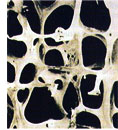Col1a1 Gene Alleles Associate with the risk of Bone Loss
(Osteoporosis - February 20, 2003)
"Allele frequencies of the G
--> T polymorphism at the regulatory region of the Col1a1 gene in the population of the northwestern Russia (control
group) and in osteoporotic patients were estimated by the RFLP method based
on PCR-mediated site-directed mutagenesis," researchers in Russia reported.
of the Col1a1 gene in the population of the northwestern Russia (control
group) and in osteoporotic patients were estimated by the RFLP method based
on PCR-mediated site-directed mutagenesis," researchers in Russia reported.
"Three patient groups with
radiologically confirmed osteoporosis were examined. Group 1 consisted of 64
patients with severe osteoporosis complicated by fractures (SO); group 2
included 15 children with idiopathic osteoporosis (IO); and group 3
consisted of 98 women with postmenopausal osteoporosis developed at the
background of estradiol-deficiency state (PMO)," wrote M.V. Moskalenko and
colleagues, Russian Academy of Science, Ott Institute for Obstetrics and
Gynecology.
"The frequency of functionally
defective alleles in the control group was 16.7%. It was statistically different from that in the SO patients (48.4%)
(p < 0.01) and in the IO children (40%) (p < 0.01). The frequency of alleles
in the PMO patients constituted 23% and it was similar to that in the
control group (p > 0.05)."
16.7%. It was statistically different from that in the SO patients (48.4%)
(p < 0.01) and in the IO children (40%) (p < 0.01). The frequency of alleles
in the PMO patients constituted 23% and it was similar to that in the
control group (p > 0.05)."
"Analysis of the Col1a1
alleles provides early detection of the individuals with hereditary
predisposition to osteoporosis and prophylaxis of the disease at the
presymptomatic stage," researchers advised.
Moskalenko and colleagues
published their study in Russian Journal of Genetics (Analysis of
association of the Col1a1 gene alleles with the risk of osteoporosis. Russ J
Genet, 2002;38(12):1443-1446).
The contact person for this
report is M.V. Moskalenko, Russian Academy of Science, Ott Institute for
Obstetrics and Gynecology, St. Petersburg 199034, Russia.
To subscribe to the Russian
Journal of Genetics, contact the publisher: Kluwer Academic, Plenum
Publishing, 233 Spring St., New York, NY 10013, USA.
The information in this
article comes under the major subject areas of Genomics and Genetics,
Hereditary Disease, and Osteoporosis. This article was prepared by Women's
Health Weekly editors from staff and other reports.
ęCopyright 2003, Biotech Week
via NewsRx.com & NewsRx.net
This story has been adapted from a news
release issued by NewsRx.com & NewsRx.net